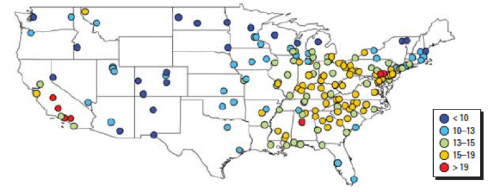
We’ve all choked on the billowing smoke of a passing truck. But poor air quality can have more serious effects that results in chronic disease, hospital admissions and even death.
Now research from the University of Ottawa links prenatal air pollution exposures to the development of two common childhood cancers.
The study of more than 2 million children in Ontario, Canada, found cancer risks in children up to age 6 that were linked to two pollutants: nitrogen dioxide and PM2.5 –microscopic particulate matter 2.5 microns or smaller in diameter. That's about seven to 70 times thinner than a human hair. These tiny particles are a threat because they can travel deep into our lungs.
Unlike adult cancer, the rate of childhood cancer has seen a small, but steady increase in recent decades. The trend points to environmental factors playing an important role. Pregnancy and early life are critical times of biological development. That makes children especially vulnerable to the effects of pollution, even before they're born.
The Canadian study shows the importance of exposure in the womb. Higher exposure to nitrogen dioxide during the first trimester increased the risk of childhood leukemia, the most common cancer in children. PM2.5 exposure throughout pregnancy, in particular during the first trimester, increased the risk of a brain tumor called an astrocytoma, which occurs with much greater frequency in children than adults.
The science on whether these air pollutants cause childhood cancer is still unsettled. But this study should raise concerns. These risks weren’t due to exceptionally dirty air. The average concentrations of both nitrogen dioxide and PM2.5 in this study were well below the U.S. Environmental Protection Agency's standards.
Knowing where pollution is highest can help us reduce our exposure. Nitrogen dioxide tends to be highest near major roads. PM2.5 can vary greatly by region and season.
Average PM2.5 Concentrations, in Micrograms per Cubic Liter, 2000-2005
 Source: Bell et al., Spatial and Temporal Variation in PM2.5 Chemical Composition in the United States for Health Effects Studies. Environmental Health Perspectives, July 2007, 115(7): 989-995.
Source: Bell et al., Spatial and Temporal Variation in PM2.5 Chemical Composition in the United States for Health Effects Studies. Environmental Health Perspectives, July 2007, 115(7): 989-995.The chemical composition of PM2.5 also varies by region and by time of year, both of which can affect health. For example, the Northeast has its highest mortality and most hospital admissions during the summer. This is a time of high sulfur pollution from coal- and oil-fired power plants.
All of this news points to the need for stronger, not weaker, environmental regulations that can adequately protect public health for future generations.
This comes at a worrisome time for the EPA’s ability to protect the environment and human health. Scott Pruitt, the nominee to head the EPA, has spent his career litigating against the same agency. Last week there were reports of a possible political review of the EPA’s scientific research. There is room for political debate of policy, but the science on which those policies are based needs to be open and objective if we are to make good decisions. As the late scientist and author Carl Sagan said, “our preferences do not determine what is true.”
We can avoid spending time outside near major roads during rush hour and keep our home air clean, but we are going to need sound policy, grounded in science, to truly protect our health.